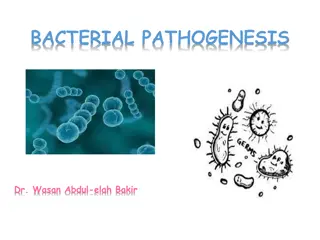Understanding the Immune System: Defenses Against Pathogens
Delve into the intricate workings of the immune system as it fights off pathogens to protect the body. Explore how external defenses like tears, saliva, and skin, along with internal defenses like inflammation and white blood cells, work together to maintain homeostasis and safeguard against sickness. Gain insights into identifying invaders, calling for help, and destroying pathogens.
Download Presentation

Please find below an Image/Link to download the presentation.
The content on the website is provided AS IS for your information and personal use only. It may not be sold, licensed, or shared on other websites without obtaining consent from the author. Download presentation by click this link. If you encounter any issues during the download, it is possible that the publisher has removed the file from their server.
E N D
Presentation Transcript
The Immune System Florida Science Fusion Unit 8 Lesson 1 Pages 544-553
Immune System To be immune means to be protected. The body system that helps fight off sickness is called the immune system. The immune system is made up of a network of cells, tissues, and organs that work together to protect the body. Immune System Movie Identify the invaders Call for help Tag the invaders Destroy the invaders Remember the invaders Quiz Matching Activity Review the Lymphatic System
Pathogen A pathogen is an organism, virus, or particle that can make you sick. Fungal Meningitis Can you name some pathogens? Bacteria blood infection Trichinella Parasite Flu virus
External Defenses What are your external defenses against pathogens? Tears and saliva tears and saliva both contain enzymes that destroy invaders. Skin Skin provides both a physical and a chemical barrier against the outside world. Mucus membranes Mucous membranes produce mucus in the nose. Structures called cilia line the body's airways and constantly wave foreign particles and mucus away from the lungs to where they can be swallowed safely.
Imagine! Think-Pair-Share If you were a pathogen, what external defenses of the host s body would you have to get past? Choose one external defense and describe your journey into the body.
Internal Defenses Inflammation Blood rushes to the cut where the pathogen entered. Platelets seal the open wound to prevent more invaders from entering. Fever The body increases its internal temperature which slows down the growth of bacteria and some other pathogens. White Blood cells Specialized cells made in the bone marrow that fight disease are produced to fight diseases.
Activity: Compare/Contrast Defenses Internal External How do our defenses help us maintain homeostasis? Homeostasis is the ability to maintain a constant internal environment. The nervous and endocrine systems control homeostasis in the body through feedback mechanisms involving various organs and organ systems. Examples of homeostatic processes in the body include temperature control, pH balance, water and electrolyte balance, blood pressure, and respiration. The Immune system is also involved with maintaining Homeostasis by using the thymus gland to send chemical messages to the white blood cells to attack invaders.
Do you remember? 1.Name 4 types of pathogens. 2.Where are white blood cells produced? 3.How does having a Fever help your body defend against pathogens?
Types of White Blood Cells The granulocytes attack any invaders in large numbers, and "eat" until they die. The pus in an infected wound consists chiefly of dead granulocytes The macrophages are big eaters of invaders. They are larger, live longer, and alert the rest of the immune system of invaders. Video 1 Video 2 Video 3 The dendritic cells are also "eater" cells and devour intruders. And like the macrophages, the dendritic cells help with the activation of the rest of the immune system. They filter body fluids to clear them of foreign organisms and particles.
White Blood Cells (Lymphocytes) White blood cells called lymphocytes originate in the bone marrow but migrate to parts of the lymphatic system such as the lymph nodes, spleen, and thymus. Antigen: Invading particle Antibody: A large Y shaped protein that is produced by the immune system to mark invaders. Each lymphocyte cell is made to match up to a specific type of antigen. Think of puzzle pieces. Video Simulation
Lymphocytes (T cells) T cells are produced in the bone marrow and move to the Thymus gland (part of the lymphatic system) when they mature. Helper T cells are the main regulators of the immune defense. Their primary task is to activate B cells and killer T cells. The helper T cells are activated when a macrophage or dendritic cell, which has eaten an invader, travels to the nearest lymph node to present information about the captured pathogen. Killer T cells are specialized for attacking cells infected by viruses and bacteria. It also attacks cancer cells. The killer T cell has receptors that are used to search each cell that it meets. If a cell is infected, it is swiftly killed.
Lymphocytes (B-cells) The B lymphocyte cell searches for antigens matching its receptors. If it finds such antigen it connects to it, and inside the B cell a triggering signal is set off. The plasma cell (created by a triggered B cell) is specialized in producing an antibody, that matches an invader. Plasma cells produce antibodies at an amazing rate and can release tens of thousands of antibodies per second. The Memory Cells are a cell type produced by the division of B cells. These cells have a prolonged life span and can thereby "remember" specific intruders. T cells can also produce memory cells with an even longer life span than B memory cells. The second time an intruder tries to invade the body, B and T memory cells help the immune system to activate much faster. The invaders are wiped out before the infected human feels any symptoms. The body has achieved immunity against the invader.
Thumbs up/Thumbs down 1. An antigen is one of our body s defense cells. 2. A macrophage is a white blood cell that does lives longer than other cells and is called a big eater . 3. T cells mature to make plasma cells and memory cells. 4. B cells form places on their surface to allow them to connect to invading cells to mark them so they can be destroyed. 5. Helper T cells are found in the Thymus gland and they activate the immune response. 6. Antibodies are Y shaped proteins produced by the immune system to attach to antigens. 7. Lymphocyte cells can match up to many different antigens.
Trace the Path of a Virus The Virus or pathogen can take two paths: Path one: They Make it into a Body cell Path two: Captured by one of the white blood cells.
Vaccine How does a vaccine work? A Vaccine is prepared using a dead or weakened pathogen and is given as a shot. The immune system responds by making T cells, B cells, and Memory cells. If the pathogen enters the body after the vaccination, Memory cells identify it and T cells and B cells begin to attack the invader. Video
Challenges to the Immune System Allergies: the immune system reacts to foreign particles that are not dangerous to most people. When you have allergies, the immune system overreacts and tries to "fight" ordinary things like grass, pollen, certain foods, or medicine. This causes the sneezing, itching, and other reactions that you get with allergies. Cancer: Cancer happens when cells that are not normal grow and spread very fast. Normal body cells grow and divide and know to stop growing. Over time, they also die. Unlike these normal cells, cancer cells just continue to grow and divide out of control and don't die when they're supposed to. Immune Deficiency: Immunodeficiency disorders are a group of disorders in which part of the immune system is missing or defective. Therefore, the body's ability to fight infections is impaired. As a result, the person with an immunodeficiency disorder will have frequent infections that are generally more severe and last longer than usual. Auto Immune Diseases: The immune system attacks the body s own cells. When the immune system makes a mistake and attacks part of the body, it is called autoimmunity. One example of an autoimmune disease is type 1 diabetes, in which the immune system destroys the cells in the pancreas that produce insulin.
Working together Our body systems work together to defend us from pathogens. Each system has specific jobs that help the immune system keep us healthy. From the list below, choose 2 systems and explain how the system helps the immune system keep us safe. Circulatory Lymphatic Respiratory Skeletal Musculatory Skin (Integumentary)
Review of the Lymphatic System The lymphatic system includes a system of lymphatic capillaries, vessels, nodes, and ducts that collect and transport lymph fluid. It works along with the rest of the immune system (mainly, the white blood cells) to fight infections. There are many clusters of lymph nodes. The most abundant places lymph nodes are found are in the neck, the armpit, and the groin. Swelling of these nodes indicates infection. Lymphatic tissue is also found in the thymus, spleen, tonsils, and appendix, along with some special tissue in the gut. Movie of Lymph Node Function
How does lymph fluid move? How does the Lymph nodes work? The lymph fluid moves through the vessels as you move the voluntary muscles in your body. Ever go on a plane and have your feet swell up? Because you are sitting in one place and not moving around, fluid collects in your feet and they swell. The more you move, the more effective your lymphatic system becomes. Lymph nodes work like a filtering system. When the body is invaded by foreign organisms, painful swelling can sometimes be felt in the neck, armpits, groin, or tonsils. The swelling comes from pathogens being trapped inside the lymph nodes. Eventually these organisms are destroyed by a type of white blood cell that lines the walls of the lymph node causing the swelling and pain to go away. C:\Users\ONEAL\AppData\Local\Microsoft\Windows\Temporary Internet Files\Content.IE5\SG3TAVSO\MC900432672[1].png























